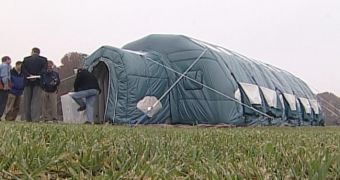The Moon base has been specially designed for future moon explorers, and resembles a structure similar to an inflatable backyard bounce for children. It will head the South Pole, for a so-called Antarctic test run, to start early next year. The prototype has been demonstrated by NASA on Wednesday at ILC Dover's Frederica, Del., facility.
The structure can be inflated, respectively deflated in about ten minutes, according to Larry Toups, habitat lead for NASA's Constellation Program Lunar Surface Systems Office. The habitat prototype will be deployed along with a number of other structures, in the Arctic environment in January next year. The main goal of the designed structure is to provide a habitat for people, which can be deployed in only a few hours. The bulky clothes used by the people at the South Pole will make the deployment procedure much more similar to the situation that the astronauts will encounter in the hard lunar environment, while being equipped with the spacesuits.
It could eventually become useful, as a multilayer test platform for many new technologies such as the health monitoring systems, self-healing materials, and protective materials against dangerous space radiation. The inflated habitats are mostly agreed by NASA due to the low weight, and the small amounts of space the structure occupies while not inflated. The habitat is part of a series of several similar models, including a prototype that is supported by eight legs, and has two pressurized cylinders connected by an airlock door, developed by the NASA engineers.
It will be inflated by researchers at McMurdo Station in Antarctica, and will be used as a staging area from January next year, until February 2009, allowing to monitor the performance of the structure, by using human reports, and data received by embedded sensors. By testing it in the Arctic environment, NASA hopes to learn how the prototype behaves in the cold weather, or how well it retains heat in the atmosphere it contains.
Researchers hope they will demonstrate how the structure can be packed in a small volume, and still be a useful, habitable volume for future lunar explorations, in extreme environments. NASA has in plan to use them in the scheduled manned mission to the Moon, as early as 2020, to set an operational lunar base for future weeklong missions.
A similar inflated structure has been deployed by Bigelow Aerospace, in the orbit of Earth, as an anticipation of the assembly of a new space station by the year 2012.

 14 DAY TRIAL //
14 DAY TRIAL //